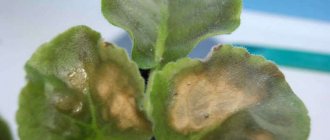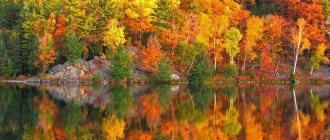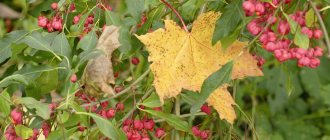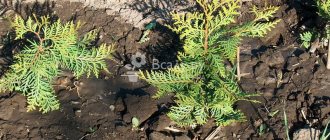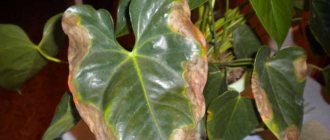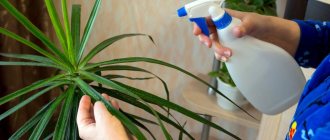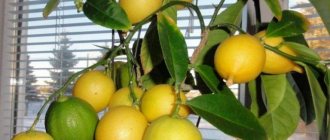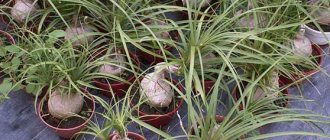Barberry cannot be called a crop that is rarely found in the middle zone, although some species grow much better in countries with warm climates. But even in our latitudes this plant is quite unpretentious, except for some diseases that appear on the foliage.
It is worth noting that in some cases, the cause of spots (less often, stripes) on barberry leaves may be varietal characteristics, especially for ornamental plant species. This, for example, is typical for Ottawa barberry Silver Miles, Thunberg barberry - Golden Ring, Pink Queen, Starburst, Silver Beauty and Maria, as well as some other varieties. But if the pattern on the foliage did not initially appear and was not intended, it is worth taking a closer look at the plant.
Proper planting of a bush is the key to its future health
Proper planting of barberry bushes
The barberry bush, which grows in urban areas, is susceptible to various plant diseases. This is due to the presence of polluted and weak soil and heavy air. With a poor habitat and insufficient care, the plant weakens and gets sick.
To avoid this, it is recommended to initially approach this issue responsibly and carry out the landing as follows:
- Let's start with choosing a site. It is better to plant bushes in an open, sunny place. Protect the plant from drafts and strong winds. It is important to avoid places where the soil is constantly wet, this will lead to the development of fungal infections and damage to the root system of the shrub.
- Soil selection. Although barberry is considered an unpretentious crop, it is better to use light, dry soil or loam for planting. It is not recommended to plant the bush in an acidic environment.
- Boarding time. The ideal time for planting is autumn or spring.
- Feeding. Raw materials from humus and earthen mixture are prepared in advance, soil from the garden is mixed with sand in equal proportions. The finished mixture is poured into the dug hole. Then twenty grams of potassium sulfate and one hundred grams of superphosphate are added.
Be careful when working with these fertilizers; you must not allow the roots of the plant to come into contact with them.
Preventive measures
Reanimating a plant is more difficult than preventing barberry diseases and insect infestations. Basic preventive measures:
- When purchasing cuttings, you need to carefully inspect the root system. If some roots are not healthy, this is a sign of weak immunity. It is not worth buying such a plant.
- Barberry should be planted in a well-ventilated and illuminated area of the site.
- A distance of at least 0.5 m should be maintained between bushes.
- Annual sanitary pruning should not be too severe.
- The material collected during pruning must be burned.
When barberry leaves curl and dry out, you need to figure out why this happens. The main reasons are considered to be disease infection and pest infestation. Proper care and regular preventative treatment will help avoid such problems.
Compliance with the rules of care is the best prevention of diseases
Protection against all infectious plant diseases is proper care. The list of necessary procedures includes:
- watering;
- loosening and weeding;
- fertilizer;
- pruning
Watering should be moderate. If it rains often and the weather is cloudy, barberry is not watered at all, because waterlogging is contraindicated for the plant. In dry weather, water the bush once a week using warm water. Only the roots are watered, it is advisable that the water does not fall on the foliage.
Weeds are removed in a timely manner and the soil is loosened to saturate the soil with oxygen. To avoid a large number of weeds and improve the properties of the soil, the area is mulched; for this you can use nut shells and sawdust.
Since fertilizers are added during planting, subsequent fertilizers are applied only the following spring. Thirty grams of urea are diluted in 10 liters of water. Nitrogen fertilizers are added every 4 years.
Timely pruning is important. A year after planting, the first manipulation is carried out - sanitary pruning, all branches are shortened by half. Then the bush is pruned twice a year - in mid-June and in early August. This procedure is carried out periodically to form the plant.
Pruning barberry bushes
An important protection and prevention against disease is the addition of calcium. With a lack of calcium, barberry becomes faded and the condition of the leaf plate is disturbed.
The lack of this substance also negatively affects fruiting and flowering, there will be few inflorescences, and the fruits will become deformed and small. Therefore, a little gypsum powder is added to the soil as soon as the first signs of calcium deficiency are noticed. Barberry returns to normal after a few days and pleases with abundant flowering and harvest.
Why doesn't barberry bloom?
Despite the decorative foliage of yellow barberry, its disease can be signaled by the absence of flowering. As a result, fruits are not formed, the bush becomes not as bright and attractive as before.
The reason for the lack of flowers may be:
- plant age is too young;
- recent barberry transplant;
- incorrectly trimmed bushes;
- increased soil acidity;
- location in the shade;
- soil is too dry or poor.
How to save barberry from bacterial cancer
Bacterial cancer of barberry
Symptoms of the disease are the formation of brown, watery, slightly blurry spots. They are especially noticeable on the inside of the leaf. If the problem is not corrected, the leaves will dry out and fall off, and the stem will die.
Cancer cannot be allowed to affect the root system or the lower part of the stem, in which case the plant is doomed.
We advise you to act quickly. Grind the mustard greens and mix everything thoroughly. Treat the soil with ready-made raw materials, adding two kilograms per square meter. Cover the ground with film. Due to this, gaseous products will begin to form, which are fatal to bacterial cancer.
In autumn or spring, treat branches and trunks with chalk or lime mortar. The product is prepared as follows: for ten liters of water, take one hundred grams of copper sulfate, two kilograms of lime, twenty grams of wood glue.
Additional ways to fight cancer:
- cut off and burn the affected areas of the bush;
- in the spring, as a preventative measure, spray with oxychloride or Bordeaux mixture;
- inspect the seedling before planting; do not use the crop even if there are minor signs of infection.
If the listed remedies do not help, then you should seek help from inhibitors or a biological drug.
Basic barberry diseases and treatment methods
Barberry plants are considered relatively disease resistant. Diseases that affect plants are cancerous or fungal in nature. When appropriate treatment measures are taken, the plant is restored.
Leaf rust
The disease is provoked by a fungus that develops due to a decrease in the protective functions of the plant. If the bush does not receive the necessary beneficial elements, it weakens. Symptoms of damage:
- orange-brown spots on leaf blades and shoots;
- On the lower surface of the leaf blade, myceliums are visible, whitish in color and round in shape.
You can get rid of it by spraying with sulfur-containing preparations. Bordeaux mixture is ideal. All foliage affected by the disease must be burned.
Leaf spot
The lesion is characterized by the appearance of white (with a grayish tint), brown, brownish and black spots. Each blight genus produces a different parasite. Poor quality treatment or not carried out on time leads to the death of the bush.
What to do if such signs are detected? Chemical agents and biological fungicides are effective. Fruit-bearing bushes need more gentle products, sprayed with them a couple of weeks before picking the berries.
Powdery mildew
The disease is caused by a fungus. When the leaves are covered with a white coating, it begins to dry out the plant. With severe damage, the foliage becomes twisted and covered with a web of cobwebs.
To treat shrubs, it is necessary to use comprehensive measures:
- treatment with a solution of soda ash and soap;
- in case of severe damage, treat with manganese solution;
- foliage needs to be burned;
- Treat the bush until flowers appear with the chemicals “Vectra”, “Skor”, and sulfur colloidal.
In case of severe damage, treat with Fitosporin. Also, for preventive purposes, seasonal spraying can be done.
Cortical necrosis
The defeat is characterized by the death of shoots, the formation of tubercles with spores that appear in the cracked bark. For treatment, cut off all diseased branches 15-17 cm beyond the area where the disease is spreading and burn. Spray the remaining branches with copper sulfate, and coat the cut areas with garden varnish.
Drying of stems
As a result of the disease, the bark is affected by fungal pathogens. Characteristic symptoms:
- the bark and crown dry out;
- branches die.
Further spread can be stopped by pruning diseased branches or spraying with a chemical or biological preparation.
See also
What is the best way to preserve blueberries fresh for the winter at homeRead
Bacteriosis
The bacterium Pseudomonas provokes the development of a cancer-related disease. Characteristic symptoms:
- watery spots on the crown, sprouts, cuttings;
- cracking of the bark, cancerous formations;
- foliage quickly dies;
- the branches swell and swells of a brownish hue form.
To combat the disease, the affected branches are cut off, burned, and the bush is treated with a chemical.
Cancers
Cancerous lesions appear as:
- cones on branches;
- cracks;
- rotten.
Cancerous formations are cleaned out, treated with copper sulfate and chemicals (“Fundazol”, “Bayleton”). When the lower part of the plant is affected, it cannot be saved.
Barberry wilt
With this disease, leaves and individual shoots wither, and on one side of the bush. The leaves of the entire plant gradually wither and curl. Darkened rings of blood vessels are visible on the sections. The causative agent is a fungus from the genus Fusarium. Infection from the soil gets to the roots, rotting occurs, and the plant dries out.
Leaf rust - super methods of fighting
The best remedy in this case is Paurin. It contains an active anticancer agent - an antagonist. This drug is non-toxic and safe for plants, animals and humans.
Barberry leaf rust
The disease is manifested by the presence of dark orange spots on the upper part of the leaves. Fungal spores form.
To eliminate the problem, you can use traditional methods:
- For 4 liters of water, take a teaspoon of dishwashing detergent, grind an aspirin tablet into powder, add a tablespoon of soda and sunflower oil. We treat the plant with prepared raw materials once a week until complete recovery.
- Fill a third of the bucket with manure, add water and leave for 3 days until ready. At the same time, stir the infusion constantly. Before use, strain and dilute with water in a ratio of 1 to 10. Apply in the evening so as not to burn the leaves.
Recommended species and varieties
More than 450 varieties of barberry are known, but only a couple of dozen are often found during cultivation. Most popular shrubs are plants with seasonal leaves, extremely decorative, and undemanding. There are also several evergreen species found in gardens, which are much more delicate and difficult to grow in our climate.
Table. Varieties of Barberry Thunberg.
| Characteristic sign | Varieties |
| Red-leaved barberry |
|
| With yellow leaves |
|
| With green leaves |
|
| With erect stems |
|
| Low, ground cover |
|
In addition to Thunberg varieties, other interesting hybrids can be found in gardens:
- “Ottawa Superba” Berberis ottavensis – with strongly raised shoots, 2-3 m high;
- Korean barberry (Berberis koreana) with large leaves and round fruits.
Of the evergreen barberries it is worth noting:
- "Julian" or "Julianna" (Berberis julianae), grows to a height of 2-3 m, with narrow and elongated lanceolate leaves, dark blue fruits.
- Warty (Berberis verruculosa) - 1.5 m high, has sharp thorns, leathery leaves, dark blue fruits.
- Darwina - tall, with beautiful yellow, delicate flowers, dark green leaves.
- Frikarta is tall, with a spherical crown.
- Ganiepena - evergreen barberry, with a spherical crown, dark blue berries.
Fighting powdery mildew using folk remedies
Powdery mildew on barberry leaves
Powdery mildew appears in the form of a gray and white coating. A product made from ash infusion shows good results. Eight liters of water will require half a bucket of ash. Insist for a day. If the product is needed urgently, the raw material is boiled and then diluted in half with water. At the end, add two tablespoons of liquid soap to add stickiness.
The second recipe is to take four grams of soda and four grams of laundry soap per liter of water, mix everything. You will need to spray the bush every 3 days.
The third recipe is to dilute kefir whey with plain water, in a ratio of one to ten.
In all three cases, the treatment result is positive.
Chemicals against barberry diseases
Since barberry is not the most popular crop in our dachas and does not get sick as often as others, the list of industrial products for treatment is not too long. And if your plant is affected by one of the ailments listed above, then as a fight you should use one of the following drugs to choose from. This is Racurs (4 ml per 5 liters of water, 2-3 sprayings with an interval of 14 days, application rate - 2 liters per plant) or Pure Flower (against powdery mildew - 2 ml per 10 liters of water, against spotting - 4 ml per 10 liters of water ; 2 sprayings with an interval of 14 days, the consumption rate of the drug is 10 l per 100 sq.m). Topaz, used according to the instructions for currants, will also save you from powdery mildew (in total, at least two treatments should be carried out with an interval of two weeks).
Phyllostic leaf spot
Symptoms of the disease appear in mid-summer. The foliage becomes covered with brown spots, which burn the leaf and create holes.
To combat, products based on copper oxychloride are used (forty grams of the substance per bucket of water). The spraying procedure is carried out in 2 stages. The first time is when the petals fall. The second - twenty days later, the third - after harvesting.
Soap detergent helps no less effectively. For 1 liter of boiling water, take three hundred grams of baby or laundry soap. Leave for 24 hours to completely dissolve. Before use, add five grams of soda and copper sulfate.
Processing times and scheme
Spraying is carried out with the preparations “Vectra”, “Skor”, “Cumulus” before and after the flowering process. If the disease develops strongly - in the fall, when the harvest is harvested.
The optimal time for spring treatment with a mixture of urea and copper sulfate is when the average air temperature is above zero, and the buds have already swollen, but have not released leaves. If the foliage has just appeared, you can also spray it; later it will be useless. In addition to pest control, nitrogen replenishment is carried out. The plant enters the growing season faster, and the flowering period shifts.
Pests are eliminated as they appear and again for prevention after 2 weeks.
It is impossible to say exactly the processing time by month, since they depend on the climatic characteristics of the region and the weather conditions of a particular year.
How to eliminate drying branches
The disease is caused by fungal infection of the upper part of the bark. Subsequently, large shoots die and the external qualities of the shrub are lost.
First of all, it is worth carrying out phytosanitary cleaning of barberry. Trim off all dry and browned shoots. Then spray with Bordeaux mixture, Abigapite or copper oxychloride.
In this case, folk remedies will not give a positive result, since their effect is weak, and when the branches dry out, you need to act very quickly.
Brief description of the plant
Barberry is a shrub of the Barberry family. An unpretentious plant that can grow on dry and rocky soils. The culture loves light, so in the wild it lives on mountain slopes and forest edges. Barberry can be grown throughout Russia.
Barberry bunch
The plant has a powerful main root, from which long rhizomes extend. The branches are elongated, with thorns and thin green leaves. Flowering begins in May - racemose inflorescences of 20-25 flowers are formed on the branches. At the beginning of autumn, barberry produces bright red oblong berries.
Infusion of mullein and ash against tracheomycosis wilt
In this case, a solution based on mullein works well. This method is absolutely safe, but effective. To prepare, you need to take three liters of water, a quarter of a bucket of mullein. Infuse for three days. Strain the finished raw material and add water to the original amount.
Ash infusion helps well against tracheomycosis. Three kilograms of wood ash are poured with eight liters of hot water and left for 48 hours. Once ready, you need to water the trunk part of the bush.
Reviews from gardeners
Sova1951
Last spring, the barberry “Aurea” began to appear brown spots on the leaves, over time they fell off completely, although I treated it with a drug against fungal diseases, then with “Baikal”. This year it has come to life again, although there is no growth at all, the same story is beginning to appear again.
Source: www.forumhouse.ru
Svetlana-S
I like to plant dwarf barberries. Unfortunately, my barberries often freeze above the snow level. If possible, I bend them with greenhouse arcs so that they go under the snow as much as possible.
Source: www.gardengallereya.ru
Barberry aphid - fighting a dangerous enemy
Barberry aphid
In order to get rid of aphids, many people use chemicals. However, these drugs saturate the soil and the plant itself with poisons and toxins, and most importantly, they negatively affect our health.
It is recommended to use a soap solution against aphids. Tar or laundry soap is grated on a coarse grater. The raw materials are infused in water, the plant is sprayed.
After the procedure, it is necessary to rinse the bush under running water to knock off the remaining insects.
Another good remedy is herbal infusion. Suitable herbs include: coriander, marigold, lavender, Dalmatian chamomile, basil, mustard, garlic and basil. You can use one of the herbs listed or use several of them at the same time.
Preparing for winter
To prepare barberry for winter, you need to prune it before the first negative temperatures. Next, you need to clear the area of cut branches and other debris, and treat areas of large cuts with a solution of garden varnish. When applying fertilizers in early autumn, additional fertilizing is not needed. In other cases, before winter, barberry is fertilized with phosphorus-potassium compounds.
If the plant cannot boast of good frost resistance, it will have to be covered with heat-insulating material. When growing representatives of the Thunberg group, additional shelter is not required.
Columnar barberries exhibit poor resistance to low temperatures. They need careful insulation using suitable materials.
To prepare barberry for winter, first of all, the inert peat where the seedlings were kept should be removed from the soil and the soil should be poured out of the planting hole. In autumn, you should hill up the root collar to 12 cm.
The most heat-loving or young specimens are subjected to the sheltering procedure. To do this, they are collected in a bundle and covered with burlap or spunbond. Using the material, you need to wrap the branches and tie them with a thick rope. The main thing is to do this carefully so as not to damage the shoots.
A large number of barberry varieties can withstand severe frosts, so excessive insulation will lead to their death. If the crop is grown in harsh climatic conditions, in order to protect the plantings from freezing, you need to collect the shoots in a bunch and tie them.
Next, a cylinder is created from a chain-link mesh above the bush so that it is larger on all sides by 10-15 cm. The remaining space is filled with dry foliage, and the outer part of the cylinder is wrapped with a dense heat insulator.
If all the rules are followed, the shelter can be removed with the onset of spring warmth.
Needles, tansy and wormwood from the barberry sawfly
The sawfly is a small black caterpillar that eats the branches and leaves of barberry.
Wormwood from the barberry sawfly
The most effective folk methods to combat it:
- Pour two kilograms of pine needles with ten liters of water. The solution is infused for seven days, it is important to stir it periodically. Store in a dark place until ready. Before use, dilute the solution with plain water, the concentration is one to three or one to five.
- Pick 1.2 kilograms of wormwood grass and place it in the sun for a couple of days. Then add a bucket of water to the dried grass and leave for three days. Strain the infusion and add fifty or one hundred grams of baking soda.
- Pour 1 kilogram of fresh tansy with eight liters of water, put on low heat and boil for two hours. When the infusion has cooled, you need to add forty grams of any liquid soap.
The result will please you: after a couple of weeks the plant is restored, and the insects die.
Common insects that harm barberry
Decorative and fruiting barberry has a pleasant aroma and tasty juice for insects. For these reasons, pests attack the bush, which results in wilted shoots, limp leaves and a weakened state of the plant as a whole. Fruiting in such bushes decreases or stops altogether due to lack of liquid filling, damage to leaves and cuttings. Let's look at the famous insects that love to eat raspberries.
Caterpillars
Larvae of different species of lepidopteran insects are found on raspberry bushes. Crooked leaf rollers, cutworms, honeysuckle moths, moths and barberry sawflies leave their offspring on the leaves, under the bark, and in the ground under plants. The larvae, feeding on the sap, are capable of causing irreparable harm to the barberry in the form of unusable twisted leaves and dried out areas of shoots, which, if left uninterrupted, leads to complete drying out of the bush.
To get rid of caterpillars on barberry in the following ways:
- three weeks before the harvest time, the bushes are sprayed with one percent Chlorophos, or Decis;
- Among the folk recipes for fighting caterpillars, infusions of wormwood and fumigation are suitable;
- Leaves eaten by larvae are removed.
Aphids on barberry
Determining the presence of aphids on a plant is not difficult, since the pest reveals itself when fed with juice and is located on the inside of the leaves. The symptoms of barberry being affected by aphids are the same as in the previous case with caterpillars, which is why the bush loses strength for normal development and looks unhealthy.
Sulfur-containing solutions are used against aphids, as well as self-prepared infusions with strong aromas. Popular advice recommends spraying barberry against aphids with garlic, tobacco, or potato decoction. To prepare the tobacco solution, take half a kilogram of shag and place it in a ten-liter bucket. Then boil water and fill the contents to the full brim. If you add another three hundred grams of grated laundry soap, the effect will only intensify. It is better to process barberry in the evening, when there is no wind.
The proposed options are also suitable for combating scale insects and scale insects.
Tick infestation of barberry
The danger of ticks is explained by the fact that this insect is capable of multiplying at an incredibly fast pace. When there are several barberry bushes on a site, the mite also attacks neighboring plants in search of juice. After small pests inhabit the barberry, swellings form, which give the shoots an unusual shape and the leaves wither. It is important to detect the mite on the plant in time and begin treatment. The adult insect increases in size and takes on an orange color.
Fitoverm is used as an anti-tick drug, which has destructive properties in three directions. The components of the insecticide remove different types of mites and thrips by introducing the poison into the body. One ampoule of Fitoverm is used per liter of liquid and sprayed on barberry for five to seven days. Also effective in the fight against ticks is the drug Talstar, which is purchased in powder and liquid form. Experienced gardeners recommend applying a control spray with an alcohol solution.
Regular inspection of barberry bushes will help to avoid unpleasant consequences from the presence of pests associated with further painful infestations. Treatment of berry plants is carried out as an annual autumn prevention.
Tick infestation
Fitoverm for tick-borne infestation of barberry
Unfortunately, there are no effective folk remedies for ticks.
The insecticidal drug Fitoverm has a detrimental effect on ticks.
The constituent components penetrate the insect's body and act as poison.
It is enough to take one ampoule of the drug per liter of water. Carry out the bush treatment procedure for a week.
After chemical spraying, we recommend spraying with alcohol to consolidate the effect.
We invite you to watch a useful video about the treatment and prevention of diseases of the barberry bush, as well as about combating its pests:
You can fight even the most serious diseases of barberry using folk methods and chemicals. The main thing is to notice the problem in time and not put off solving it for a long period.
Why diseases may occur
This occurs due to a decrease in the plant’s immune system. The cause may be increased humidity during prolonged rains or improper watering.
Improper care
Mallow diseases - causes and description
Barberry does not require special care, but certain recommendations should be followed. Excessive watering, failure to fertilize, lack of loosening, and improper pruning can cause insects and diseases. If the summer is very hot, it is important to spray.
Important! Due to lack of moisture, the plant’s immunity decreases, which can lead to the appearance of cancer on its branches and stems.
Barberry - beneficial properties
Long before our era, barberry berries were used as an effective remedy for rejuvenation, blood purification, and treatment of many diseases. Mentions of this were found on clay tablets made by the ancient Assyrians.
The enormous value of barberry has now been scientifically proven. The set of useful substances it contains can remove toxins, cleanse the body, slow down the aging process, restore damaged cells, cope with inflammatory processes in the body, prevent cardiovascular diseases, and resist atherosclerosis.
And this is just a small list of the healing benefits of the “caramel tree,” which can not only give us health, but also bring a piece of beauty, harmony and charm into our lives.
Barberry propagation
How to propagate barberry
Reproduction of barberry is possible in a generative way, that is, by seeds, and vegetatively - by cuttings, layering and dividing the bush. Each of these methods has its own advantages and disadvantages, but having information about each of them will make it easier for you to make a choice.
Growing barberry from seeds
Collect ripe barberry berries, separate the seeds from the fruit pulp, hold them for several minutes in a solution of potassium permanganate, and then dry. In the fall, the seeds are sown directly into the soil of the training bed to a depth of 1 cm; in the spring, after the appearance of two true leaves, the seedlings are thinned out so that there is a distance of at least three centimeters between them. Seedlings are grown in a training bed for two years, and then transplanted to a permanent place.
If you decide to sow barberry seeds in the spring, then you will first have to stratify them - mix the seeds with sand and keep them for two to five months in the refrigerator at a temperature of 2-5 ºC. Barberry seedlings transplanted to a permanent place bear fruit 2-3 years after germination, but only if the barberry at the dacha is represented by not one, but several bushes - barberries bear fruit only with cross-pollination.
Barberry propagation
Barberry cuttings are cut in mid-June early in the morning. The lower leaves are removed from the segments, and the upper ones are shortened by half. The cuttings are dipped for several hours in a solution of a root former - Epin, Kornevin, heteroauxin, then they are washed in water and planted in a greenhouse in a moist substrate of approximately the following composition: one part each of humus, fertile soil and peat with the addition of half a part of sand. Build a transparent, removable dome for the greenhouse in which the cuttings will stay for about two weeks. The lid is lifted from time to time to ventilate the cuttings, and after they have rooted, they are removed completely. Cuttings of barberry also involve growing seedlings in a training bed for two years until transplanting to a permanent place.
Reproduction of barberry by layering
In the spring, select a strong annual shoot from the lower branches of the bush, bend it to the ground, place it in a pre-made groove about 20 cm deep, secure it in it and fill the groove with earth, leaving only the top of the shoot on the surface. By autumn, the cuttings will take root, and you will have ready-made seedlings that will need to be transplanted and grown.
Reproduction of barberry by dividing the bush
This method is good for short plant species that have reached three to five years of age, in which the root collar is buried at least 10 cm. In the spring, dig up the bush and cut it into several approximately equal parts. You may have to use a pruning saw in addition to the pruning shears to separate the barberry root, but proceed carefully, being careful not to injure the plant too much. After dividing the bush, treat all sections with crushed coal and plant the divisions. If the shoots on a barberry begin to branch above the soil level, it should not be propagated by dividing the bush.
